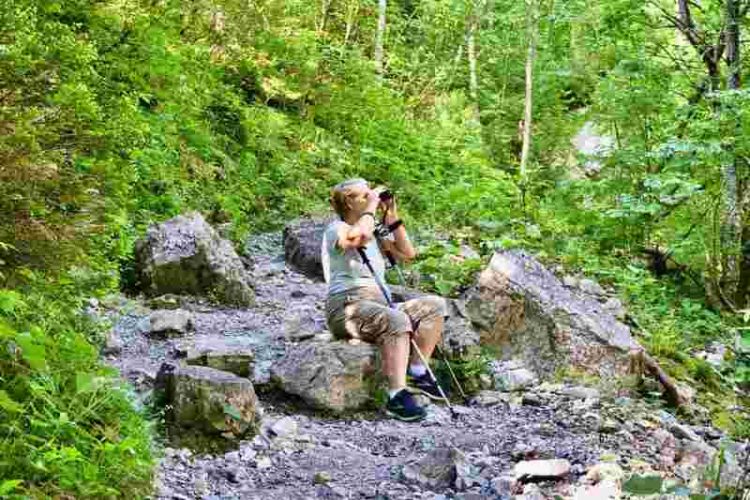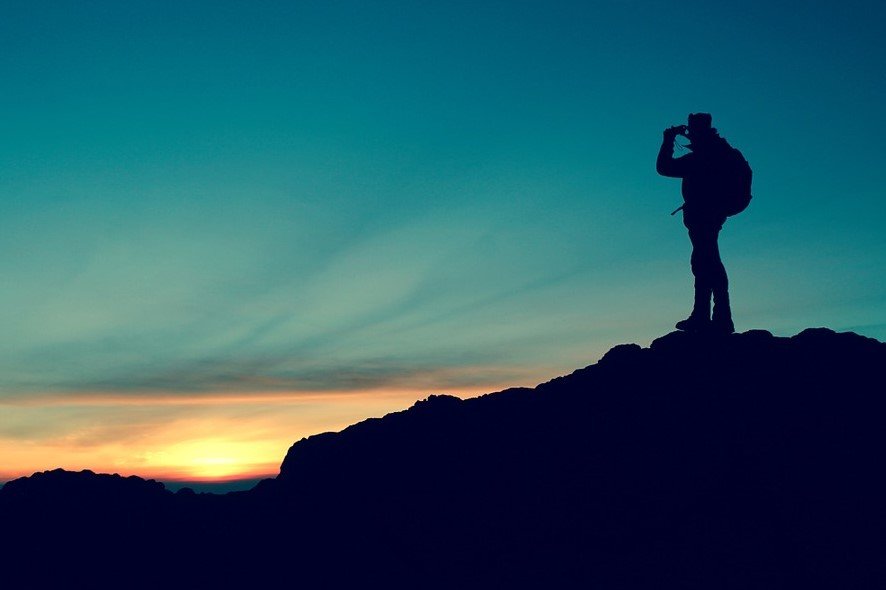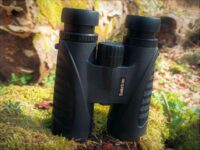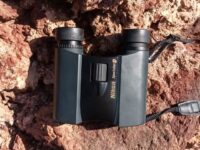This post contains affiliate links. If you follow a link I may earn a small commission at no extra cost for you.
Really good binoculars for hiking, trekking, or day trips should not be missing on any excursion into nature. Especially in remote natural landscapes, there will always be many opportunities for extensive nature observation or bird watching.
Binoculars for Hiking And Day Trips
Depending on the length of the hike or the difficulty of the tour, you might have to carry a lot of equipment with you. So binoculars for hiking shouldn’t be big and heavy but still have good optical performance and should work well and be reliably even in the most adverse weather.
Fortunately, there are a lot of good, compact, lightweight binoculars that are well suited for hiking and day trips. However, there are also a lot of really bad cheap binoculars with which nature or wildlife viewing is not much fun.
If you are experienced in the outdoors, then you already know what you need and you probably don’t really need my advice. But for all those who are not yet familiar with binoculars, I have put together some recommendations and a few of the most important tips that can be helpful to separate the wheat from the chaff. Because when choosing the most suitable binoculars, features and specs have to be considered in regard to the kind of observation, what you are going to view, and in which environment you are.

How much are binoculars for Hiking?
Inexpensive binoculars are available in discount stores in supermarkets and online. There are plenty of binoculars that hardly cost a hundred dollars and promise powerful magnification and high optical performance. However, a lot more is hidden inside binoculars than the layman sees at first glance.
You likely won’t find really good binoculars in discount stores. For those, you have to go to an outdoor shop, the hunting store, or order them online. But if you are new to binoculars and you are going to a specialist shop for the first time, you might be in for a surprise at what the really good high-end binoculars cost.
This is because binoculars are precession tools that are complex to design and manufacture and require a high level of technical knowledge. With good eyeglasses against any visual impairment, nobody is surprised that they cost several hundred dollars. And that for only two lenses in a wireframe. While binoculars can have 10 or more lenses installed, plus prisms.
Also, the internet is full of binoculars review sites promoting cheap binoculars. Reading through some of them, you doubt whether the person ever held binoculars in their hand or understands the fundamentals of optics.
Ok, back to binoculars that are useful for hikes and day tours. I don’t want to dive too deep into the technology and laws of optics. In the Know-How Category, I have posted articles about the workings of binoculars in an easy-to-understand way. If you are interested, there may be something you can learn from there to help you understand what really matters in binoculars. Then it is easier to find hiking binoculars that also suit your personal needs.
Compact binoculars for hiking
You don’t necessarily have to take expensive, super binoculars with you on difficult hikes or day trips. It’s more about finding good binoculars that are a sensible compromise between optical performance and purchase price.
Small, compact binoculars are some of the most practical for hiking. Thanks to their small dimensions and the folding bridge between the two tubes they fold down really small so they can easily find space in any jacket pocket or in the side pocket of a daypack.
[amazon box=”B000NO5OYA,B008KW5K00,B017I1SA3C” grid=”3″]
Using compact binoculars pros and cons
The magnification of the small compact glasses is usually in the range of 8x 10x or 12x. More is not recommended because it can be difficult to hold the binos still, especially with such light instruments due to the trembling of the hand.
The lenses usually have a diameter of 20 to 25 mm. This is absolutely sufficient for daytime observations when there is enough light around for most situations. But in dark forests or in the twilight a practiced user will notice that the images are no longer displayed as brightly.
This is due to the fact that such a small entrance lens only collects light to a limited extent and that the exit pupil (lens diameter/magnification = exit pupil) is also quite small. In low light, our pupil’s eyes may open much wider than the cone of the binoculars’ exit pupil light beam, which then reduces viewing comfort.
This disadvantage of compact binoculars can be partially compensated for by using better optical glass and fully multicoated lenses to increase transmission. This is of course reflected in the purchase price.
If you use binoculars to scan the scenery and landscape or view occasional bird- and wildlife mainly during the day when there is enough light, then a small, inexpensive pocket binocular is perfectly sufficient for most hikers.
However, if you use the binoculars regularly and also intend to use them for wildlife or bird watching, it is definitely worth investing a little more money to buy high-quality and more powerful binoculars that offer pleasant viewing comfort even when looking through for a longer period of time.
30mm class – the Perfect size binoculars for hiking
Binoculars with a lens diameter of around 30mm are most ideal for hiking and day trips. Instruments of this size collect enough light to allow good viewing even in slightly low light conditions, e.g. in twilight or on dull overcast days.
[amazon box=”B01BFX28R8,B01MTG3OO8,B01M4P4ZV2″ grid=”3″]
Using 30 mm class of binoculars
Binoculars of the 30 mm class in combination with an 8x magnification are the best compromise. With 8x magnification, these devices have an exit pupil of 4 mm. This is ideal to have enough observation fun and viewing comfort even on cloudy days as the large exit pupil gets plenty of light to reach your eye.
A 10x magnification may be better, especially if you want to see objects in a little more detail than 8x allows. But 10 times magnification with a 30mm lens is at the expense of a slightly smaller exit pupil, which reduces the viewing comfort in poor light.
The disadvantage of a smaller exit pupil can be compensated for if you invest in a device with better glass, fully multi-coated lenses, and phase-corrected prisms. The higher quality of the device, the better you are equipped, also for poorer lighting conditions, even in overcast misty weather or in the dark forest.
For twilight observation or at night, you will soon come to the limits of this 30mm size class, especially if you prefer a 10-fold magnification. Then maybe the 40 mm class is better suited.
Are 10×42 Binoculars Too Big and heavy for hikers?
Binoculars of the 40mm class are almost too heavy and bulky for hikers to be conveniently packed. Sure, in terms of their optical performance in low light, they are way better than the smaller ones.
The large aperture ensures more light gathering, and larger is always better for optical instruments in terms of contrast and higher resolution. And with the 8x times magnification, you get a wide 5.25 mm exit pupil, and with 10x power, it is still 4.2 mm. Both good values that are plenty to observe birds and wildlife even on really dull days.
So it may be worth considering whether you use the binoculars a lot in a bad light that the advantages in performance outweigh the advantages in weight.
But do you really need that as a hiker? Usually, you are out, and about during bright daylight, and that’s it bright enough the compacts of the 20 to 30 mm class are sufficient.
So?
Choosing the right binoculars for hiking, and not only for hiking but also for hunting or birding, is always a personal matter. What works for one nature lover won’t do for the other.
Too many factors play a role alongside magnification and objective lens diameter; the quality of glass, the lenses, and coatings, the field of view, eye relief if you wear glasses, water resistance, fog proofed, durability, and handling in icy conditions or in the humid tropics, etc. And of course, the price, what are you ready to spend.
The really good instruments from renowned traditional manufacturers such as Leica, Swarovski or Zeiss can cost a few thousand dollars, depending on the design and optical performance.
[amazon box=”B016X5NU4I,B08DJ6RLHG,B018T3XYOS” grid=”3″]
But there are also cheap ones under 50 dollars, but they mostly perform poorly and not last long and no nature lover will be satisfied with them.
Most users will find good binoculars with good value for money in the middle price segment of a few hundred dollars.



